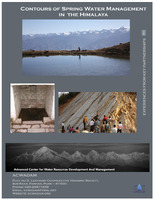Items
Tag
Water Resource Sustainability
-
 Contours of Spring Water Management in the Himalaya The document "Contours of Spring Water Management in the Himalaya" by ACWADAM highlights the critical role of spring water in sustaining the rural populations of the Indian Himalaya, where approximately 60% of people rely on natural springs for drinking and irrigation. The Himalayan region, characterized by diverse geological structures, poses significant challenges to groundwater management due to its complex hydrogeology, which affects aquifer continuity and spring discharge. As many springs are drying up or becoming seasonal due to climate change and human activities, there is an urgent need for effective water management practices that involve community participation and a thorough understanding of the geological context. ACWADAM has been actively engaged in research and action programs focusing on hydrogeological studies and spring water conservation in partnership with various organizations. Their efforts include detailed investigations to characterize spring recharge areas, monitor water quality, and implement community-based spring management systems. Through collaborations with organizations like CHIRAG and Himmotthan, ACWADAM aims to integrate scientific knowledge into local practices, ensuring that interventions are informed by geological realities and hydrological principles. This approach is essential for developing sustainable water management strategies that address both the immediate needs of local communities and the long-term viability of spring resources. In conclusion, the document emphasizes the need for a paradigm shift in how spring water resources are managed in the Himalaya. By focusing on hydrogeological education and community engagement, ACWADAM aims to enhance the resilience of these vital water sources in the face of changing climatic conditions and increasing demand. Future research initiatives are necessary to deepen the understanding of groundwater dynamics and inform policies that promote sustainable practices. This holistic approach is crucial for securing water availability for rural populations reliant on these springs, thus ensuring their livelihoods and well-being.
Contours of Spring Water Management in the Himalaya The document "Contours of Spring Water Management in the Himalaya" by ACWADAM highlights the critical role of spring water in sustaining the rural populations of the Indian Himalaya, where approximately 60% of people rely on natural springs for drinking and irrigation. The Himalayan region, characterized by diverse geological structures, poses significant challenges to groundwater management due to its complex hydrogeology, which affects aquifer continuity and spring discharge. As many springs are drying up or becoming seasonal due to climate change and human activities, there is an urgent need for effective water management practices that involve community participation and a thorough understanding of the geological context. ACWADAM has been actively engaged in research and action programs focusing on hydrogeological studies and spring water conservation in partnership with various organizations. Their efforts include detailed investigations to characterize spring recharge areas, monitor water quality, and implement community-based spring management systems. Through collaborations with organizations like CHIRAG and Himmotthan, ACWADAM aims to integrate scientific knowledge into local practices, ensuring that interventions are informed by geological realities and hydrological principles. This approach is essential for developing sustainable water management strategies that address both the immediate needs of local communities and the long-term viability of spring resources. In conclusion, the document emphasizes the need for a paradigm shift in how spring water resources are managed in the Himalaya. By focusing on hydrogeological education and community engagement, ACWADAM aims to enhance the resilience of these vital water sources in the face of changing climatic conditions and increasing demand. Future research initiatives are necessary to deepen the understanding of groundwater dynamics and inform policies that promote sustainable practices. This holistic approach is crucial for securing water availability for rural populations reliant on these springs, thus ensuring their livelihoods and well-being.
